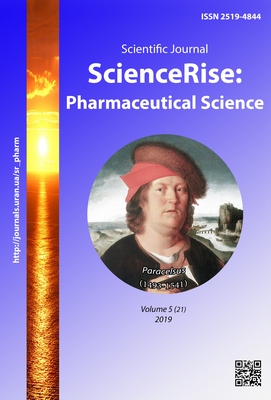Дослідження структурно-механічних властивостей основ при розробці стоматологічногогелю комбінованого складу
DOI:
https://doi.org/10.15587/2519-4852.2019.182398Ключові слова:
гель, гелеутворювач, карбомери, реологія, в’язкість, стоматологічний лікарський засібАнотація
Мета. Розробка складу стоматологічного гелю для лікування інфекційно-запальних захворювань порожнини роту з урахуванням фізико-хімічних властивостей активних фармацевтичних інгредієнтів, а саме обґрунтування виду та концентрації гелеутворювача та інших допоміжних речовин.
Методи. Визначення органолептичних характеристик, однорідності зразків гелю, рН водного витягу, показника структурної в’язкості проводили за методиками Державної фармакопеї України. Реологічні дослідження проводили за допомогою ротаційного віскозиметра обертового типу BROOKFIELD DV-II+PRO (США) з системою коаксіальних циліндрів.
Результати. З метою вибору оптимального складу гелевої основи були напрацьовані експериментальні зразки з різними гелеутворювачами (Carbopol®974P, Carbopol® 934P, Carbopol® Ultrez 10, ксантанова камідь, натрію альгінат, натрію кармелоза) та досліджено їх органолептичні характеристики, структурну в’язкість та колоїдну стабільність. Проведені фізико-хімічні та реологічні дослідження дозволяють зробити висновок про раціональність використання гелеутворювача карбополу марки Ultrez 10 в концентрації 1,1 %. При виборі нейтралізуючих агентів в дослідженнях використовували натрію гідроксид і трометамол. За результатами досліджень в якості нейтралізатора був обраний натрію гідроксид в концентрації 0,32 %, який забезпечує максимальну, стабільну в'язкість в інтервалі рН від 5,0 до 7,0.
Висновки. Розроблено склад основи стоматологічного гелю для лікування інфекційно-запальних захворювань порожнини роту: карбопол марки Ultrez 10 – 1,1 %, розчин натрію гідрооксиду 10 %–0,32 %
Посилання
- Artiushkevich, A. S. (2006). Zabolevaniia periodonta. Moscow: Medicinskaia literatura, 306.
- Lukianchuk, V. D., Hordiichuk, D. O. (2015). Suchasnyi stan pytannia patohenezu parodontytu ta yoho farmakokorektsii (ohliad literatury). Medytsyna sohodni i zavtra, 2 (67), 14–22.
- Kingman, A., Albandar, J. M. (2002). Methodological aspects of epidemiological studies of periodontal diseases. Periodontology 2000, 29 (1), 11–30. doi: http://doi.org/10.1034/j.1600-0757.2002.290102.x
- Tüzüner, T., Ulusoy, A. T., Baygin, O., Yahyaoglu, G., Yalcin, I., Buruk, K., Nicholson, J. (2013). Direct and Transdentinal (Indirect) Antibacterial Activity of Commercially Available Dental Gel Formulations againstStreptococcus mutans. Medical Principles and Practice, 22 (4), 397–401. doi: http://doi.org/10.1159/000347234
- Vynohradova, O. M. (2013). Vykorystannia suchasnykh antymikrobnykh i protyzapalnykh preparativ mistsevoi dii v likuvanni zapalnykh zakhvoriuvan parodontu. Zdobutky klinichnoi i eksperymentalnoi medytsyny, 2, 47–49.
- Mazur, I. P., Peredrii, V. A., Dulko, S. V. (2010). Farmakolohichni zasoby dlia mistsevoho likuvannia tkanyn parodontu. Sovremennaia stomatolohyia, 5, 47–52.
- Derzhavna farmakopeia Ukrainy. Vol. 2 (2014). Kharkiv: Derzhavne pidpryiemstvo «Naukovo-ekspertnyi farmakopeinyi tsentr yakosti likarskykh zasobiv», 724.
- European Pharmacopoeia (2016). EDQM. Strasbourg: Council of Europe, 4016.
- Rescala, B., Rosalem, W., Teles, R. P., Fischer, R. G., Haffajee, A. D., Socransky, S. S. et. al. (2010). Immunologic and Microbiologic Profiles of Chronic and Aggressive Periodontitis Subjects. Journal of Periodontology, 81 (9), 1308–1316. doi: http://doi.org/10.1902/jop.2010.090643
- Davtian, L. L. (2006). Naukovo-praktychne obgruntuvannia tekhnolohii miakykh likarskykh form dlia stomatolohii. Kyiv, 304.
- Ofner, C. M., Klech-Gelotte, C. M.; Swarbrick, J., Boylan, J. C. (Eds.) (2002). Gels and jellies. Encyclopedia of Pharmaceutical Tehnology. Vol. 2. NewYork: Basel: MarselDekker, 1327–1344.
- Rahman, M. N. A., Qader, O. A. J. A., Sukmasari, S., Ismail, A. F., Doolaanea, A. A. (2017). Rheological Characterization of Different Gelling Polymers for Dental Gel Formulation. Journal of Pharmaceutical Sciences and Research, 9 (12), 2633–2640.
- Rowe, R. C., Sheskey, P. J., Cook, W. G., Fenton, M. E. (Eds.) (2012). Hand book of Pharmaceutical Excipients. London:Pharmaceutical Press, 1064.
- Volovyk, N. V. (2008). Rozrobka i standartyzatsiia protyzapalnykh preparativ u formi heliv. Kharkiv, 20.
- Islam, M. T., Rodríguez-Hornedo, N., Ciotti, S., Ackermann, C. (2004). Rheological Characterization of Topical Carbomer Gels Neutralized to Different pH. Pharmaceutical Research, 21 (7), 1192–1199. doi: http://doi.org/10.1023/b:pham.0000033006.11619.07
- Carbopol® Ultrez 10 Polymer (2002). Technical Data Sheet (TDS-225). Lubrizol: Cleveland.
- Carbopol® Ultrez 21 Polymer (2002). Technical Data Sheet (TDS-297). Lubrizol: Cleveland.
- Malkin, A. IA., Isaev, A. I. (2007). Reologiia: koncepcii, metody, prilozheniia. Saint Petersburg: Professiia, 557.
- Aupova, R., Sakipova, Z., Zemlicka, M. (2014). Study of rheological properties of carbomer gels. Life Science Journal, 11, 25–27.
- Gladukh, Ie. V., Grubnik, I. M., Kukhtenko, G. P., Stepanenko, S. V. (2015). Rheological studies of water-ethanol solutions of gel-formers. Journal of Chemical and Pharmaceutical Research, 7 (4), 729–734.
- Davtian, L. L., Vashchuk, V. A., Polyshchuk, Yu. P. (2013). Reolohichni doslidzhennia yak osnova tekhnolohichnoho protsesu u razi stvorennia novoho likarskoho zasobu. Farmatsevtychnyi zhurnal, 4, 52–58.
- Singh, V. K., Anis, A., Banerjee, I., Pramanik, K., Bhattacharya, M. K., Pal, K. (2014). Preparation and characterization of novel carbopol based bigels for topical delivery of metronidazole for the treatment of bacterial vaginosis. Materials Science and Engineering: C, 44, 151–158. doi: http://doi.org/10.1016/j.msec.2014.08.026
- United States Pharmacopeia and National Formulary 2017 [USP 40 – NF35] (2016). Rockville: UnitedStatesPharmacopeialConvention, Inc, 7970.
- Opredelenie sposoba vvedeniia v osnovu aktivnykh farmacevticheskikh ingredientov stomatologicheskogo gelia (2019). Aktualnye problemy sovremennoi mediciny i farmacii. Minsk, 1545.
##submission.downloads##
Опубліковано
Як цитувати
Номер
Розділ
Ліцензія
Авторське право (c) 2019 Volodymyr Yakovenko, Dmytro Orlenko, Liliia Vyshnevska

Ця робота ліцензується відповідно до Creative Commons Attribution 4.0 International License.
Наше видання використовує положення про авторські права Creative Commons CC BY для журналів відкритого доступу.









